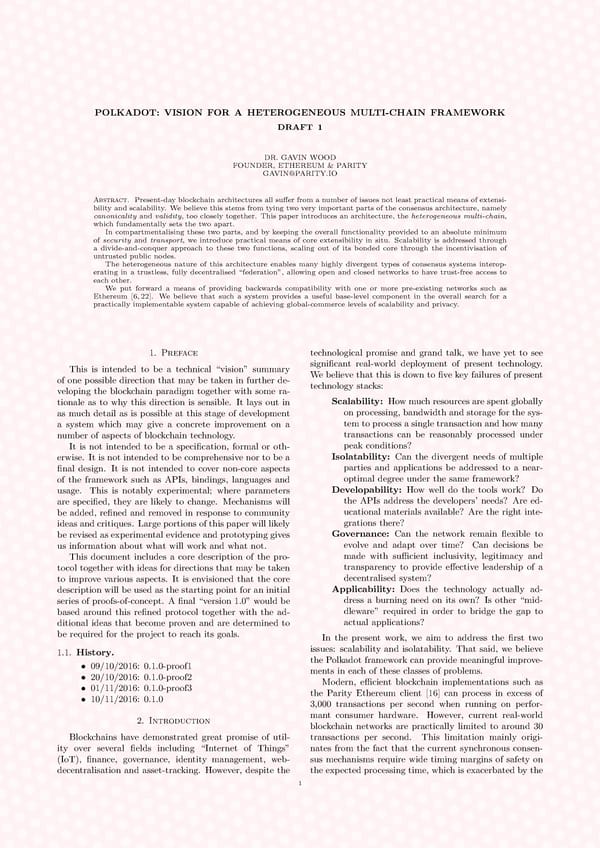POLKADOT: VISION FOR A HETEROGENEOUS MULTI-CHAIN FRAMEWORK DRAFT 1 DR. GAVIN WOOD FOUNDER, ETHEREUM&PARITY [email protected] Abstract. Present-day blockchain architectures all suffer from a number of issues not least practical means of extensi- bility and scalability. We believe this stems from tying two very important parts of the consensus architecture, namely canonicality and validity, too closely together. This paper introduces an architecture, the heterogeneous multi-chain, which fundamentally sets the two apart. In compartmentalising these two parts, and by keeping the overall functionality provided to an absolute minimum of security and transport, we introduce practical means of core extensibility in situ. Scalability is addressed through a divide-and-conquer approach to these two functions, scaling out of its bonded core through the incentivisation of untrusted public nodes. The heterogeneous nature of this architecture enables many highly divergent types of consensus systems interop- erating in a trustless, fully decentralised “federation”, allowing open and closed networks to have trust-free access to each other. We put forward a means of providing backwards compatibility with one or more pre-existing networks such as Ethereum [6,22]. We believe that such a system provides a useful base-level component in the overall search for a practically implementable system capable of achieving global-commerce levels of scalability and privacy. 1. Preface technological promise and grand talk, we have yet to see This is intended to be a technical “vision” summary significant real-world deployment of present technology. of one possible direction that may be taken in further de- Webelieve that this is down to five key failures of present veloping the blockchain paradigm together with some ra- technology stacks: tionale as to why this direction is sensible. It lays out in Scalability: How much resources are spent globally as much detail as is possible at this stage of development on processing, bandwidth and storage for the sys- a system which may give a concrete improvement on a temtoprocess a single transaction and how many number of aspects of blockchain technology. transactions can be reasonably processed under It is not intended to be a specification, formal or oth- peak conditions? erwise. It is not intended to be comprehensive nor to be a Isolatability: Can the divergent needs of multiple final design. It is not intended to cover non-core aspects parties and applications be addressed to a near- of the framework such as APIs, bindings, languages and optimal degree under the same framework? usage. This is notably experimental; where parameters Developability: How well do the tools work? Do are specified, they are likely to change. Mechanisms will the APIs address the developers’ needs? Are ed- be added, refined and removed in response to community ucational materials available? Are the right inte- ideas and critiques. Large portions of this paper will likely grations there? be revised as experimental evidence and prototyping gives Governance: Can the network remain flexible to us information about what will work and what not. evolve and adapt over time? Can decisions be This document includes a core description of the pro- made with sufficient inclusivity, legitimacy and tocol together with ideas for directions that may be taken transparency to provide effective leadership of a to improve various aspects. It is envisioned that the core decentralised system? description will be used as the starting point for an initial Applicability: Does the technology actually ad- series of proofs-of-concept. A final “version 1.0” would be dress a burning need on its own? Is other “mid- based around this refined protocol together with the ad- dleware” required in order to bridge the gap to ditional ideas that become proven and are determined to actual applications? be required for the project to reach its goals. In the present work, we aim to address the first two 1.1. History. issues: scalability and isolatability. That said, we believe • 09/10/2016: 0.1.0-proof1 the Polkadot framework can provide meaningful improve- • 20/10/2016: 0.1.0-proof2 ments in each of these classes of problems. • 01/11/2016: 0.1.0-proof3 Modern, efficient blockchain implementations such as • 10/11/2016: 0.1.0 the Parity Ethereum client [16] can process in excess of 3,000 transactions per second when running on perfor- 2. Introduction mant consumer hardware. However, current real-world blockchain networks are practically limited to around 30 Blockchains have demonstrated great promise of util- transactions per second. This limitation mainly origi- ity over several fields including “Internet of Things” nates from the fact that the current synchronous consen- (IoT), finance, governance, identity management, web- sus mechanisms require wide timing margins of safety on decentralisation and asset-tracking. However, despite the the expected processing time, which is exacerbated by the 1
 POLKADOT Page 1 Page 3
POLKADOT Page 1 Page 3